University Report: Mind Map of Wearable Technology and Team Dynamics
VerifiedAdded on 2021/06/17
|8
|1466
|129
Report
AI Summary
This report delves into the evolution of wearable technology, starting from the abacus ring in 1644 to modern devices like smartwatches and smart clothes, highlighting its increasing applications in various fields such as medicine, security, and sports. The core of the report analyzes the project's team dynamics using Bruce Tuckman's stages of team formation: forming, storming, norming, performing, and adjourning. It discusses how the team navigated each stage, including initial challenges like leader dominance, conflicts, and the eventual development of mutual understanding and respect, leading to effective project execution and a successful mind map submission. The report concludes by emphasizing the validity of Tuckman's theory in the context of the project's real-world experience and the benefits of following a structured approach to team management.
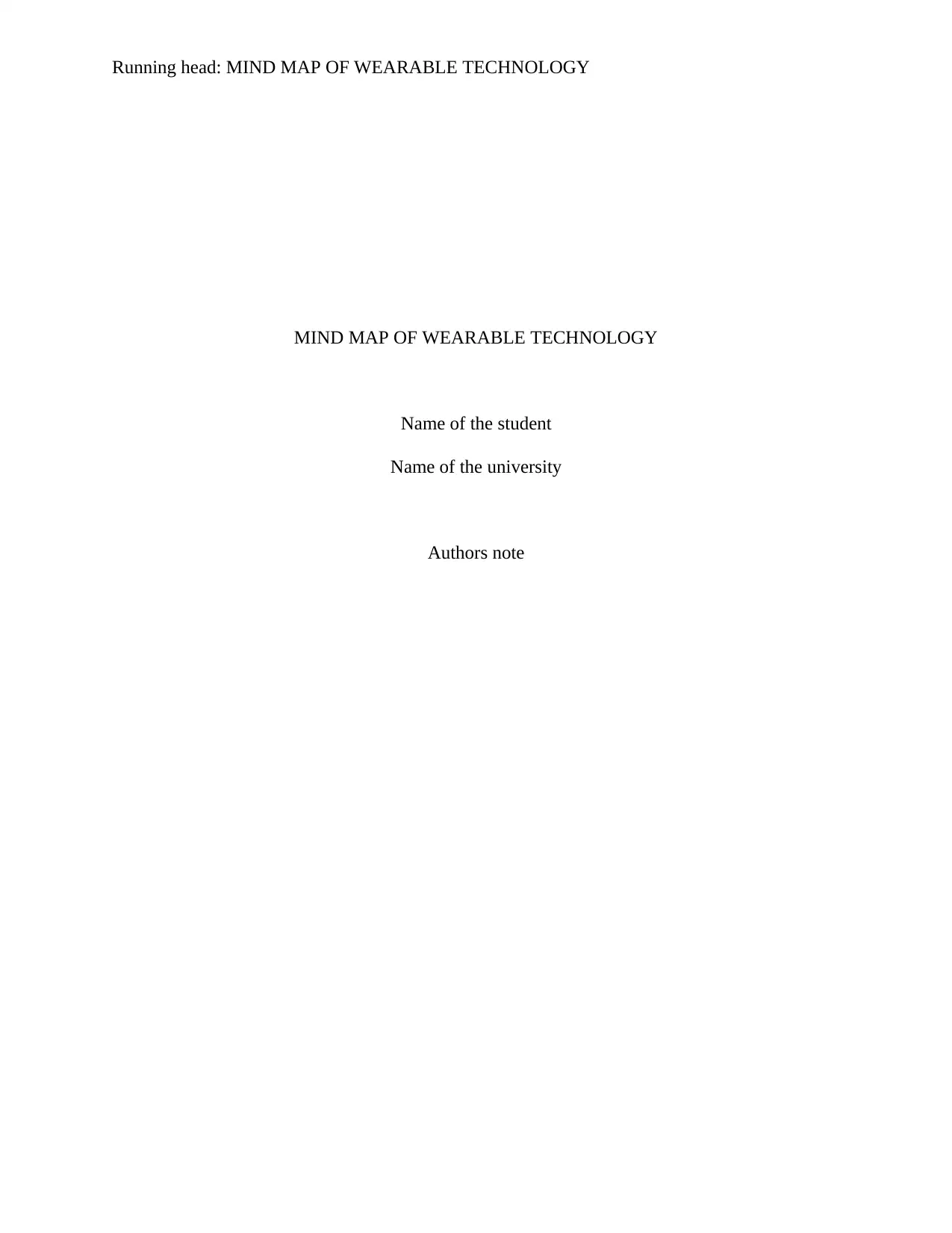
Running head: MIND MAP OF WEARABLE TECHNOLOGY
MIND MAP OF WEARABLE TECHNOLOGY
Name of the student
Name of the university
Authors note
MIND MAP OF WEARABLE TECHNOLOGY
Name of the student
Name of the university
Authors note
Paraphrase This Document
Need a fresh take? Get an instant paraphrase of this document with our AI Paraphraser
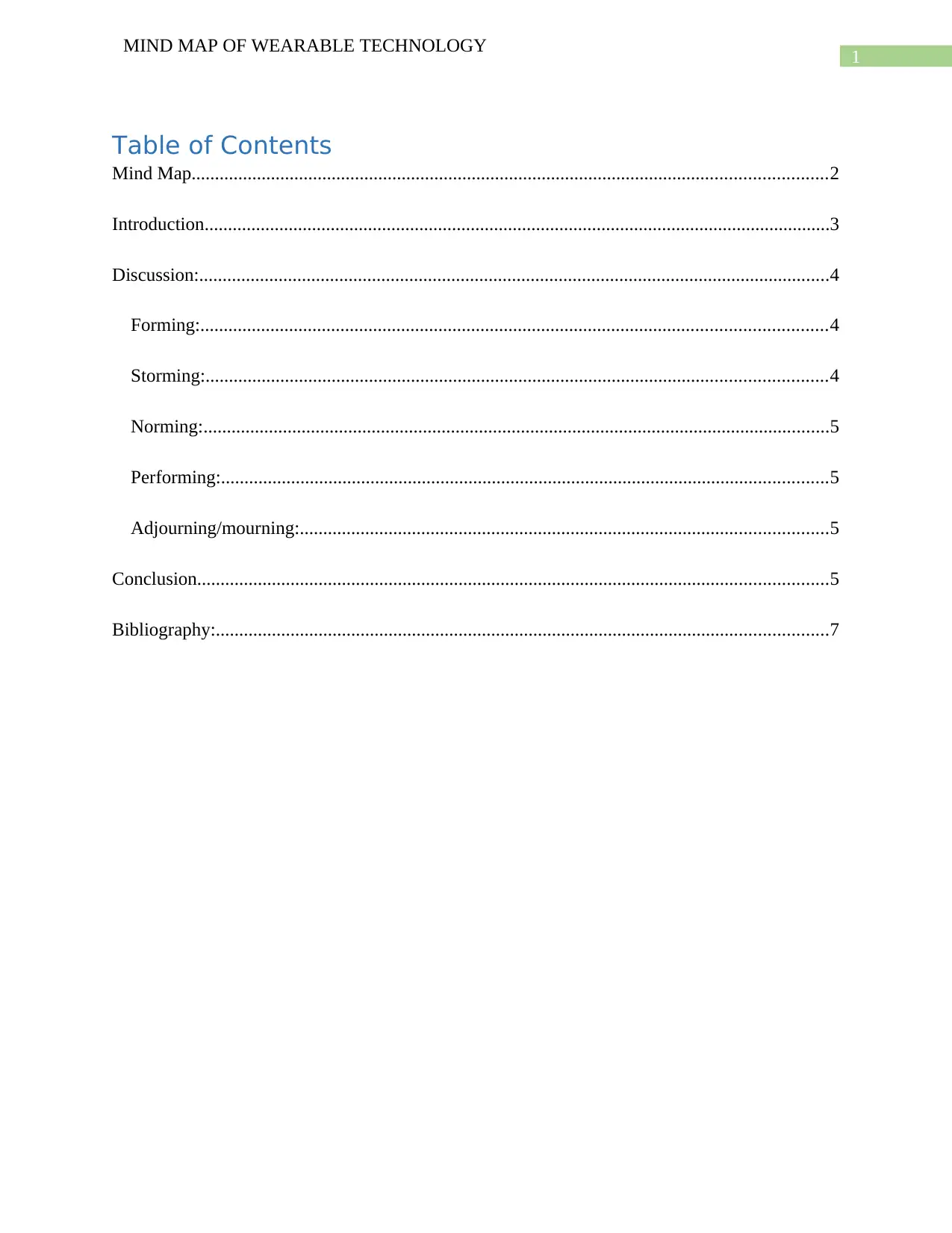
1
MIND MAP OF WEARABLE TECHNOLOGY
Table of Contents
Mind Map........................................................................................................................................2
Introduction......................................................................................................................................3
Discussion:.......................................................................................................................................4
Forming:......................................................................................................................................4
Storming:.....................................................................................................................................4
Norming:......................................................................................................................................5
Performing:..................................................................................................................................5
Adjourning/mourning:.................................................................................................................5
Conclusion.......................................................................................................................................5
Bibliography:...................................................................................................................................7
MIND MAP OF WEARABLE TECHNOLOGY
Table of Contents
Mind Map........................................................................................................................................2
Introduction......................................................................................................................................3
Discussion:.......................................................................................................................................4
Forming:......................................................................................................................................4
Storming:.....................................................................................................................................4
Norming:......................................................................................................................................5
Performing:..................................................................................................................................5
Adjourning/mourning:.................................................................................................................5
Conclusion.......................................................................................................................................5
Bibliography:...................................................................................................................................7
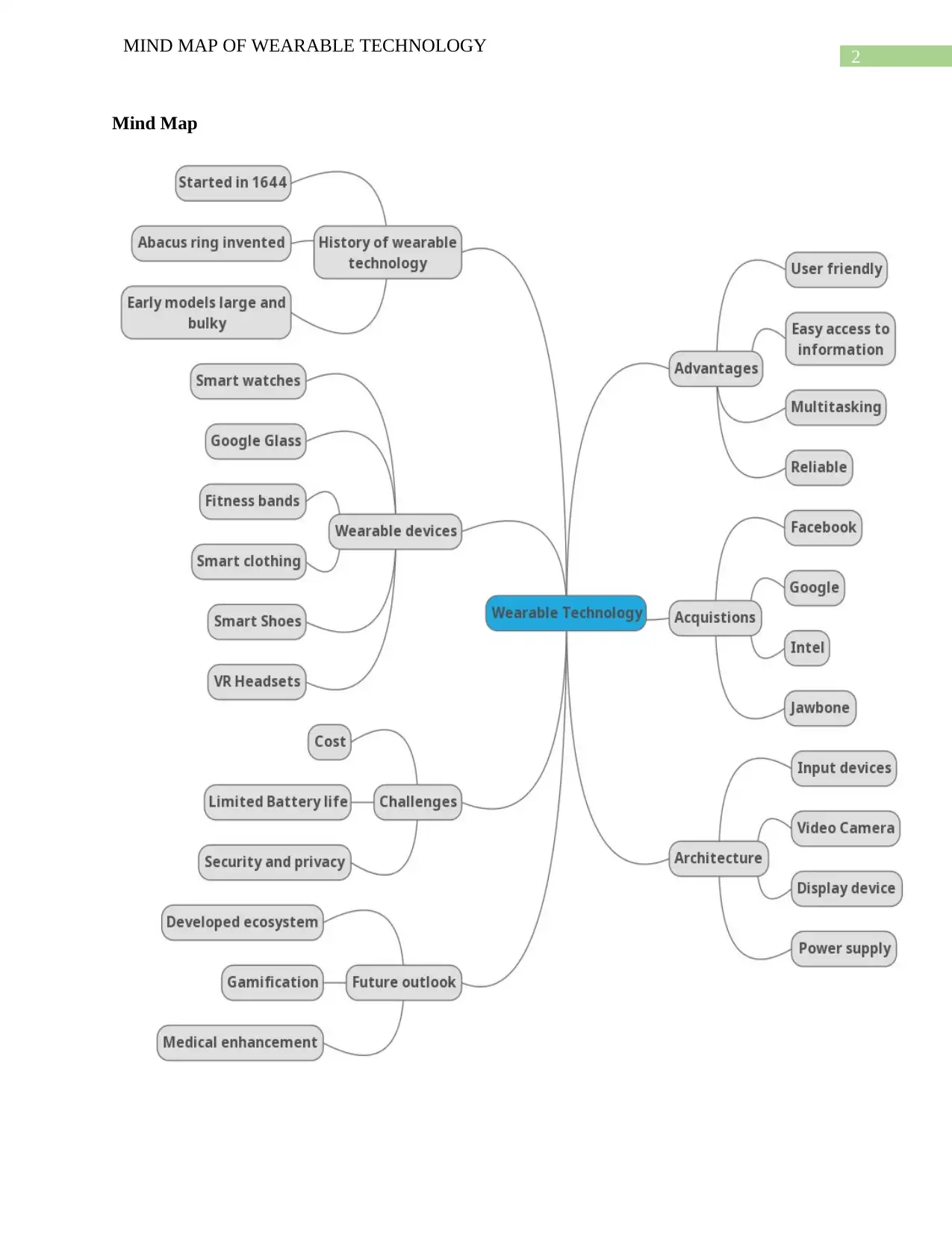
2
MIND MAP OF WEARABLE TECHNOLOGY
Mind Map
MIND MAP OF WEARABLE TECHNOLOGY
Mind Map
⊘ This is a preview!⊘
Do you want full access?
Subscribe today to unlock all pages.

Trusted by 1+ million students worldwide
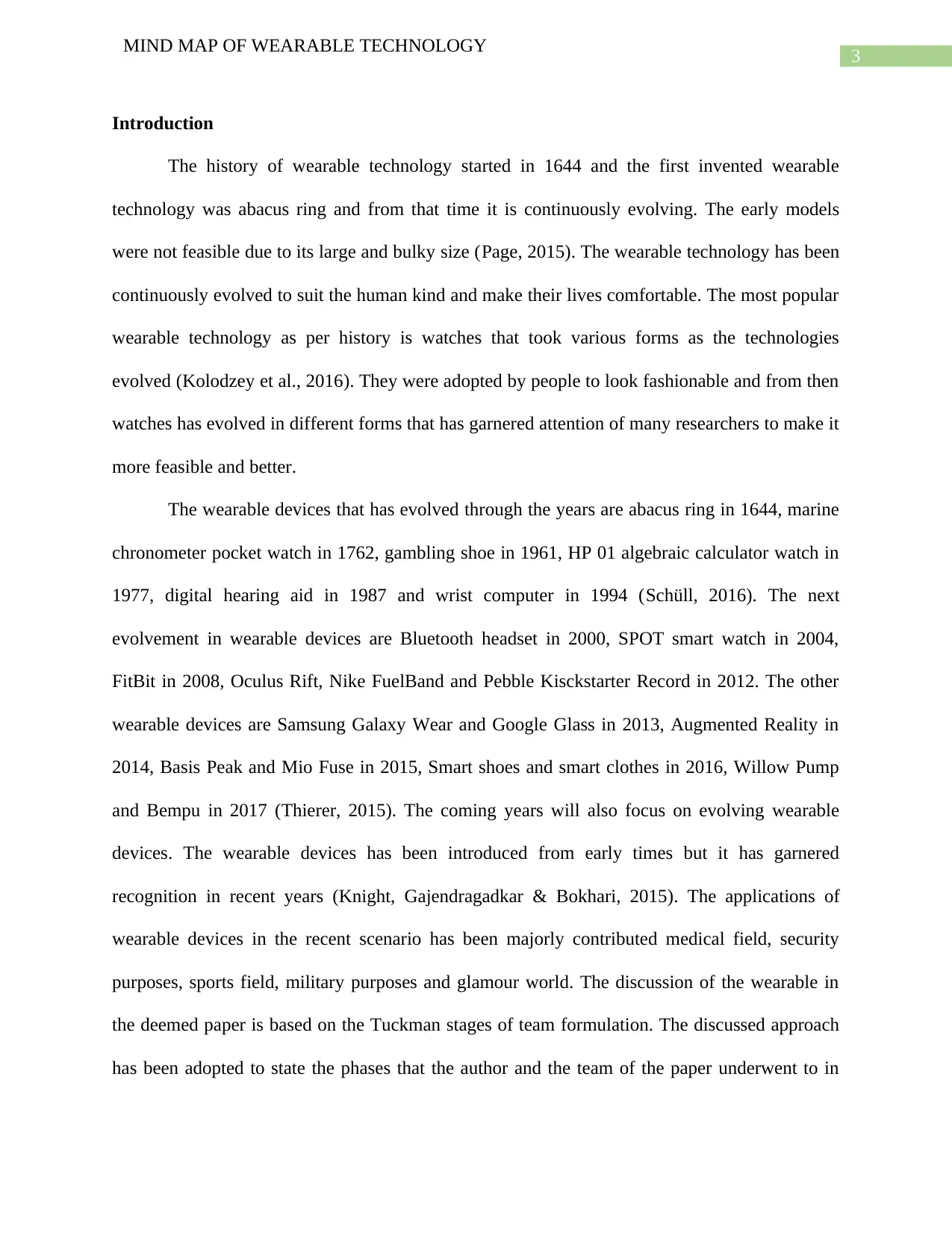
3
MIND MAP OF WEARABLE TECHNOLOGY
Introduction
The history of wearable technology started in 1644 and the first invented wearable
technology was abacus ring and from that time it is continuously evolving. The early models
were not feasible due to its large and bulky size (Page, 2015). The wearable technology has been
continuously evolved to suit the human kind and make their lives comfortable. The most popular
wearable technology as per history is watches that took various forms as the technologies
evolved (Kolodzey et al., 2016). They were adopted by people to look fashionable and from then
watches has evolved in different forms that has garnered attention of many researchers to make it
more feasible and better.
The wearable devices that has evolved through the years are abacus ring in 1644, marine
chronometer pocket watch in 1762, gambling shoe in 1961, HP 01 algebraic calculator watch in
1977, digital hearing aid in 1987 and wrist computer in 1994 (Schüll, 2016). The next
evolvement in wearable devices are Bluetooth headset in 2000, SPOT smart watch in 2004,
FitBit in 2008, Oculus Rift, Nike FuelBand and Pebble Kisckstarter Record in 2012. The other
wearable devices are Samsung Galaxy Wear and Google Glass in 2013, Augmented Reality in
2014, Basis Peak and Mio Fuse in 2015, Smart shoes and smart clothes in 2016, Willow Pump
and Bempu in 2017 (Thierer, 2015). The coming years will also focus on evolving wearable
devices. The wearable devices has been introduced from early times but it has garnered
recognition in recent years (Knight, Gajendragadkar & Bokhari, 2015). The applications of
wearable devices in the recent scenario has been majorly contributed medical field, security
purposes, sports field, military purposes and glamour world. The discussion of the wearable in
the deemed paper is based on the Tuckman stages of team formulation. The discussed approach
has been adopted to state the phases that the author and the team of the paper underwent to in
MIND MAP OF WEARABLE TECHNOLOGY
Introduction
The history of wearable technology started in 1644 and the first invented wearable
technology was abacus ring and from that time it is continuously evolving. The early models
were not feasible due to its large and bulky size (Page, 2015). The wearable technology has been
continuously evolved to suit the human kind and make their lives comfortable. The most popular
wearable technology as per history is watches that took various forms as the technologies
evolved (Kolodzey et al., 2016). They were adopted by people to look fashionable and from then
watches has evolved in different forms that has garnered attention of many researchers to make it
more feasible and better.
The wearable devices that has evolved through the years are abacus ring in 1644, marine
chronometer pocket watch in 1762, gambling shoe in 1961, HP 01 algebraic calculator watch in
1977, digital hearing aid in 1987 and wrist computer in 1994 (Schüll, 2016). The next
evolvement in wearable devices are Bluetooth headset in 2000, SPOT smart watch in 2004,
FitBit in 2008, Oculus Rift, Nike FuelBand and Pebble Kisckstarter Record in 2012. The other
wearable devices are Samsung Galaxy Wear and Google Glass in 2013, Augmented Reality in
2014, Basis Peak and Mio Fuse in 2015, Smart shoes and smart clothes in 2016, Willow Pump
and Bempu in 2017 (Thierer, 2015). The coming years will also focus on evolving wearable
devices. The wearable devices has been introduced from early times but it has garnered
recognition in recent years (Knight, Gajendragadkar & Bokhari, 2015). The applications of
wearable devices in the recent scenario has been majorly contributed medical field, security
purposes, sports field, military purposes and glamour world. The discussion of the wearable in
the deemed paper is based on the Tuckman stages of team formulation. The discussed approach
has been adopted to state the phases that the author and the team of the paper underwent to in
Paraphrase This Document
Need a fresh take? Get an instant paraphrase of this document with our AI Paraphraser
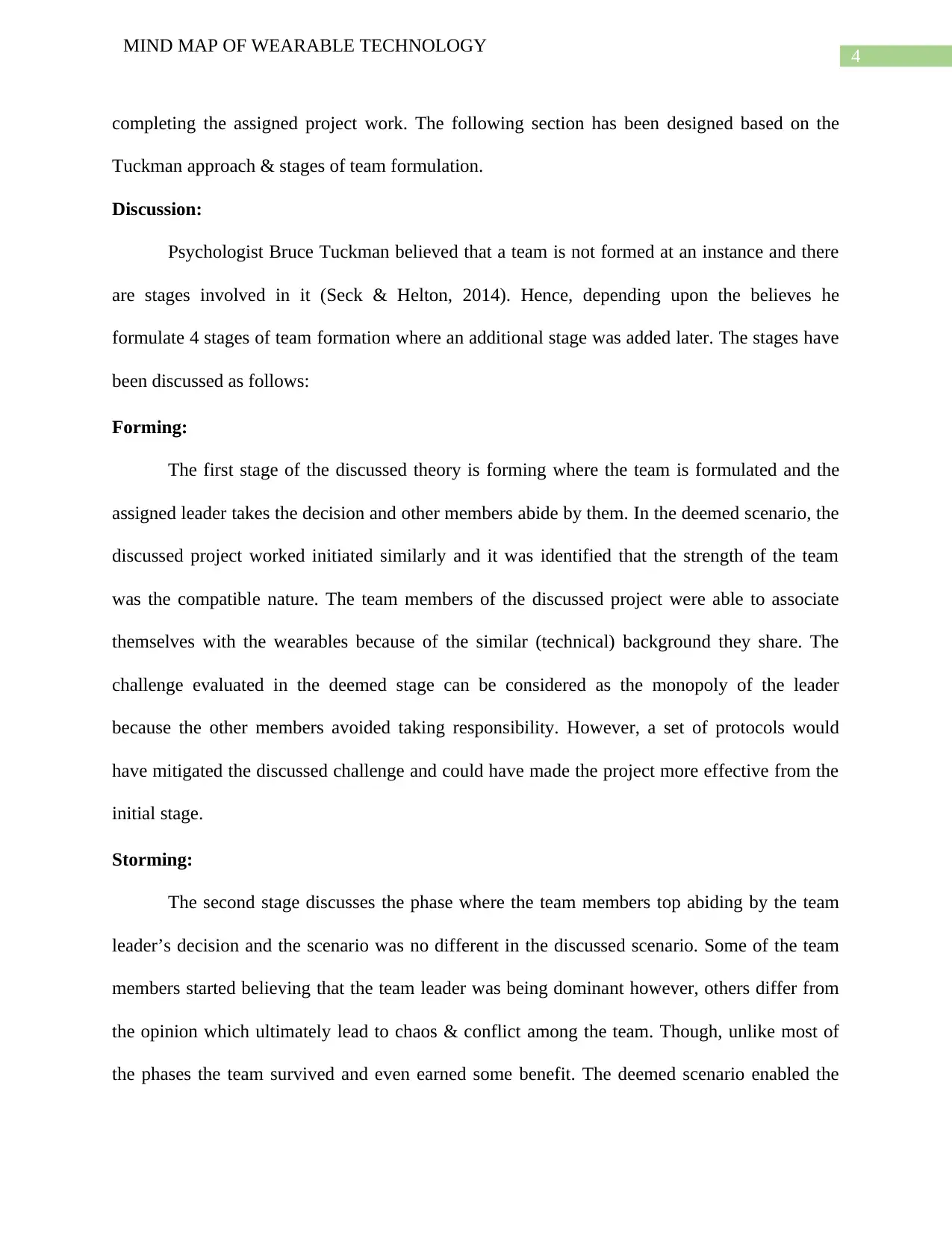
4
MIND MAP OF WEARABLE TECHNOLOGY
completing the assigned project work. The following section has been designed based on the
Tuckman approach & stages of team formulation.
Discussion:
Psychologist Bruce Tuckman believed that a team is not formed at an instance and there
are stages involved in it (Seck & Helton, 2014). Hence, depending upon the believes he
formulate 4 stages of team formation where an additional stage was added later. The stages have
been discussed as follows:
Forming:
The first stage of the discussed theory is forming where the team is formulated and the
assigned leader takes the decision and other members abide by them. In the deemed scenario, the
discussed project worked initiated similarly and it was identified that the strength of the team
was the compatible nature. The team members of the discussed project were able to associate
themselves with the wearables because of the similar (technical) background they share. The
challenge evaluated in the deemed stage can be considered as the monopoly of the leader
because the other members avoided taking responsibility. However, a set of protocols would
have mitigated the discussed challenge and could have made the project more effective from the
initial stage.
Storming:
The second stage discusses the phase where the team members top abiding by the team
leader’s decision and the scenario was no different in the discussed scenario. Some of the team
members started believing that the team leader was being dominant however, others differ from
the opinion which ultimately lead to chaos & conflict among the team. Though, unlike most of
the phases the team survived and even earned some benefit. The deemed scenario enabled the
MIND MAP OF WEARABLE TECHNOLOGY
completing the assigned project work. The following section has been designed based on the
Tuckman approach & stages of team formulation.
Discussion:
Psychologist Bruce Tuckman believed that a team is not formed at an instance and there
are stages involved in it (Seck & Helton, 2014). Hence, depending upon the believes he
formulate 4 stages of team formation where an additional stage was added later. The stages have
been discussed as follows:
Forming:
The first stage of the discussed theory is forming where the team is formulated and the
assigned leader takes the decision and other members abide by them. In the deemed scenario, the
discussed project worked initiated similarly and it was identified that the strength of the team
was the compatible nature. The team members of the discussed project were able to associate
themselves with the wearables because of the similar (technical) background they share. The
challenge evaluated in the deemed stage can be considered as the monopoly of the leader
because the other members avoided taking responsibility. However, a set of protocols would
have mitigated the discussed challenge and could have made the project more effective from the
initial stage.
Storming:
The second stage discusses the phase where the team members top abiding by the team
leader’s decision and the scenario was no different in the discussed scenario. Some of the team
members started believing that the team leader was being dominant however, others differ from
the opinion which ultimately lead to chaos & conflict among the team. Though, unlike most of
the phases the team survived and even earned some benefit. The deemed scenario enabled the
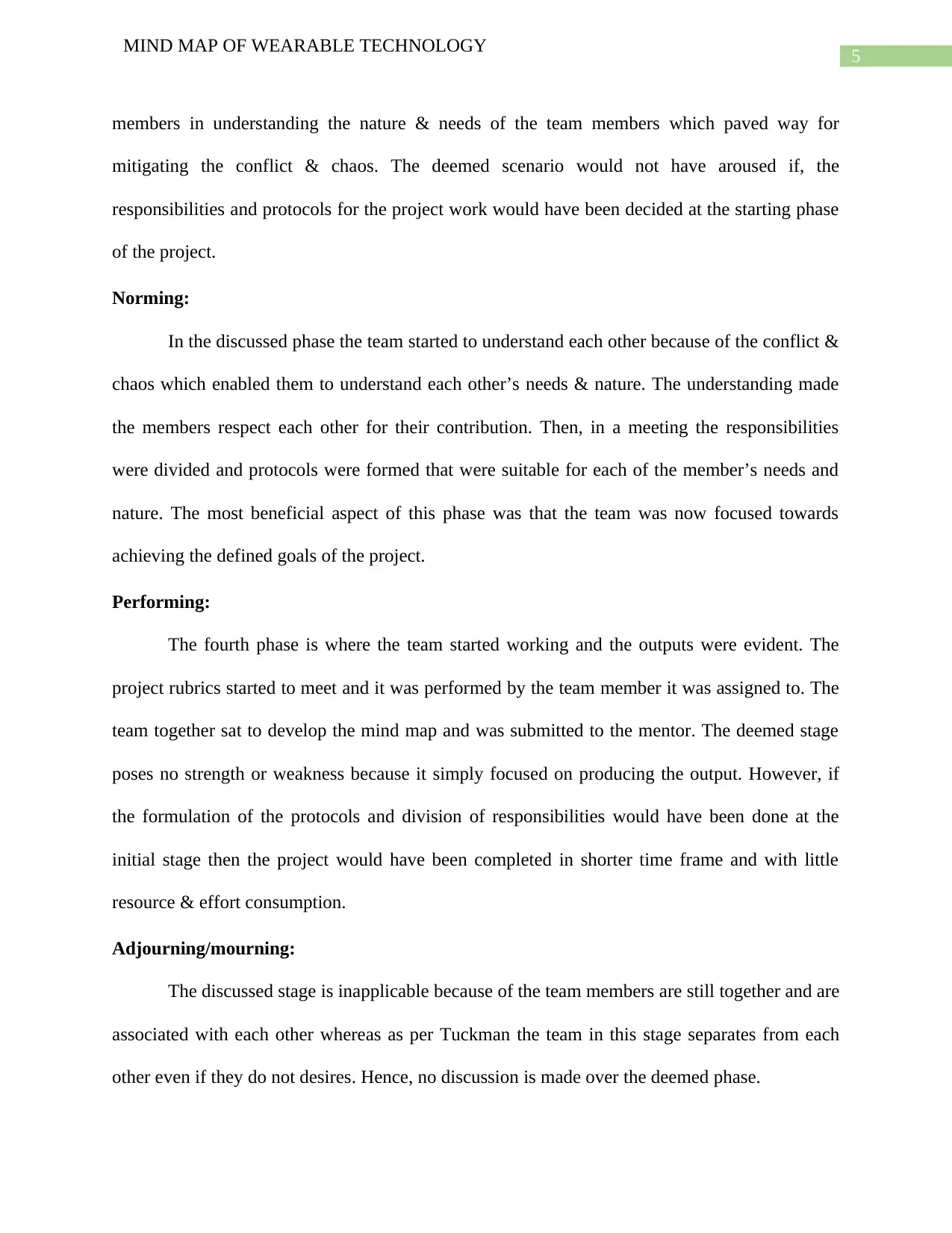
5
MIND MAP OF WEARABLE TECHNOLOGY
members in understanding the nature & needs of the team members which paved way for
mitigating the conflict & chaos. The deemed scenario would not have aroused if, the
responsibilities and protocols for the project work would have been decided at the starting phase
of the project.
Norming:
In the discussed phase the team started to understand each other because of the conflict &
chaos which enabled them to understand each other’s needs & nature. The understanding made
the members respect each other for their contribution. Then, in a meeting the responsibilities
were divided and protocols were formed that were suitable for each of the member’s needs and
nature. The most beneficial aspect of this phase was that the team was now focused towards
achieving the defined goals of the project.
Performing:
The fourth phase is where the team started working and the outputs were evident. The
project rubrics started to meet and it was performed by the team member it was assigned to. The
team together sat to develop the mind map and was submitted to the mentor. The deemed stage
poses no strength or weakness because it simply focused on producing the output. However, if
the formulation of the protocols and division of responsibilities would have been done at the
initial stage then the project would have been completed in shorter time frame and with little
resource & effort consumption.
Adjourning/mourning:
The discussed stage is inapplicable because of the team members are still together and are
associated with each other whereas as per Tuckman the team in this stage separates from each
other even if they do not desires. Hence, no discussion is made over the deemed phase.
MIND MAP OF WEARABLE TECHNOLOGY
members in understanding the nature & needs of the team members which paved way for
mitigating the conflict & chaos. The deemed scenario would not have aroused if, the
responsibilities and protocols for the project work would have been decided at the starting phase
of the project.
Norming:
In the discussed phase the team started to understand each other because of the conflict &
chaos which enabled them to understand each other’s needs & nature. The understanding made
the members respect each other for their contribution. Then, in a meeting the responsibilities
were divided and protocols were formed that were suitable for each of the member’s needs and
nature. The most beneficial aspect of this phase was that the team was now focused towards
achieving the defined goals of the project.
Performing:
The fourth phase is where the team started working and the outputs were evident. The
project rubrics started to meet and it was performed by the team member it was assigned to. The
team together sat to develop the mind map and was submitted to the mentor. The deemed stage
poses no strength or weakness because it simply focused on producing the output. However, if
the formulation of the protocols and division of responsibilities would have been done at the
initial stage then the project would have been completed in shorter time frame and with little
resource & effort consumption.
Adjourning/mourning:
The discussed stage is inapplicable because of the team members are still together and are
associated with each other whereas as per Tuckman the team in this stage separates from each
other even if they do not desires. Hence, no discussion is made over the deemed phase.
⊘ This is a preview!⊘
Do you want full access?
Subscribe today to unlock all pages.

Trusted by 1+ million students worldwide
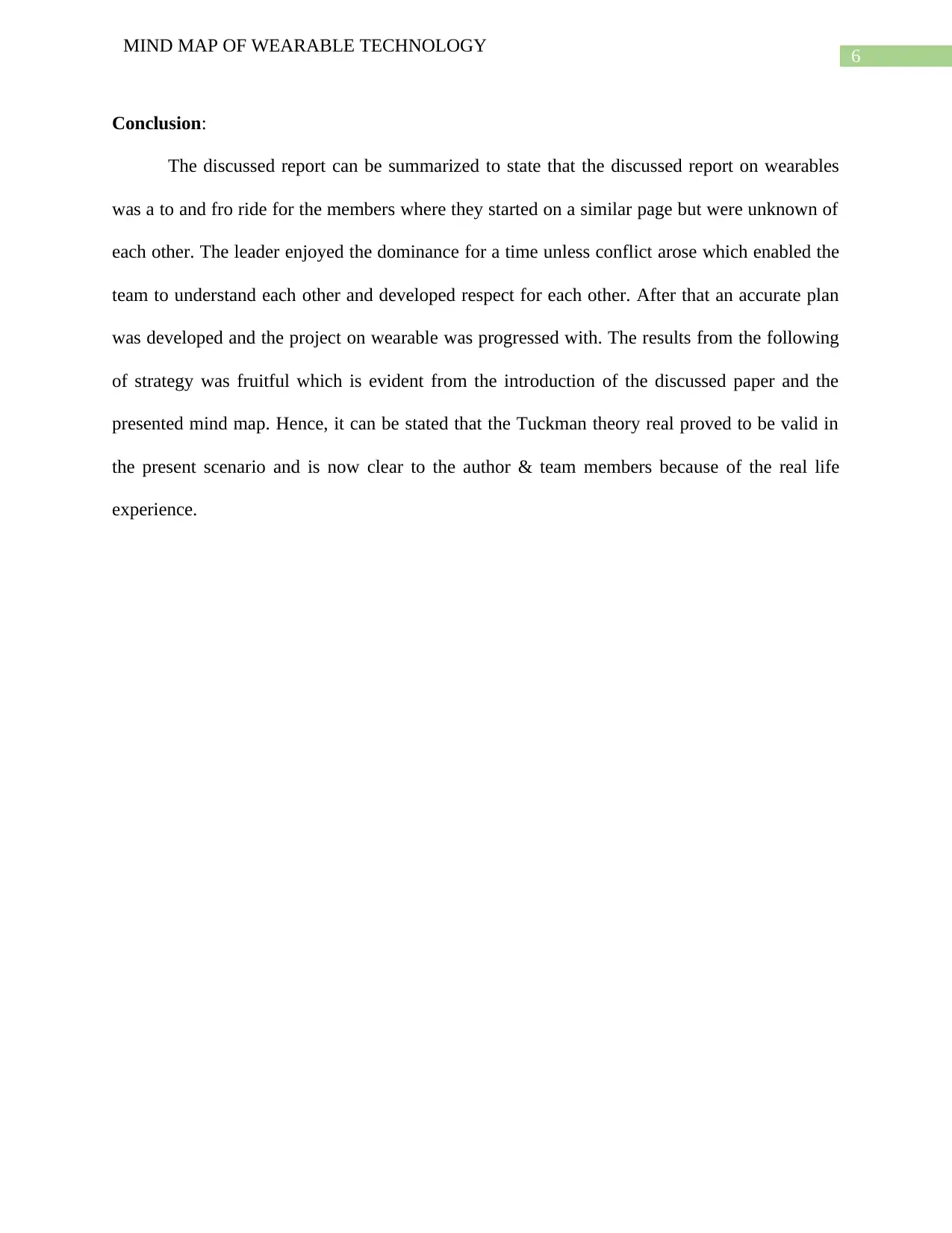
6
MIND MAP OF WEARABLE TECHNOLOGY
Conclusion:
The discussed report can be summarized to state that the discussed report on wearables
was a to and fro ride for the members where they started on a similar page but were unknown of
each other. The leader enjoyed the dominance for a time unless conflict arose which enabled the
team to understand each other and developed respect for each other. After that an accurate plan
was developed and the project on wearable was progressed with. The results from the following
of strategy was fruitful which is evident from the introduction of the discussed paper and the
presented mind map. Hence, it can be stated that the Tuckman theory real proved to be valid in
the present scenario and is now clear to the author & team members because of the real life
experience.
MIND MAP OF WEARABLE TECHNOLOGY
Conclusion:
The discussed report can be summarized to state that the discussed report on wearables
was a to and fro ride for the members where they started on a similar page but were unknown of
each other. The leader enjoyed the dominance for a time unless conflict arose which enabled the
team to understand each other and developed respect for each other. After that an accurate plan
was developed and the project on wearable was progressed with. The results from the following
of strategy was fruitful which is evident from the introduction of the discussed paper and the
presented mind map. Hence, it can be stated that the Tuckman theory real proved to be valid in
the present scenario and is now clear to the author & team members because of the real life
experience.
Paraphrase This Document
Need a fresh take? Get an instant paraphrase of this document with our AI Paraphraser
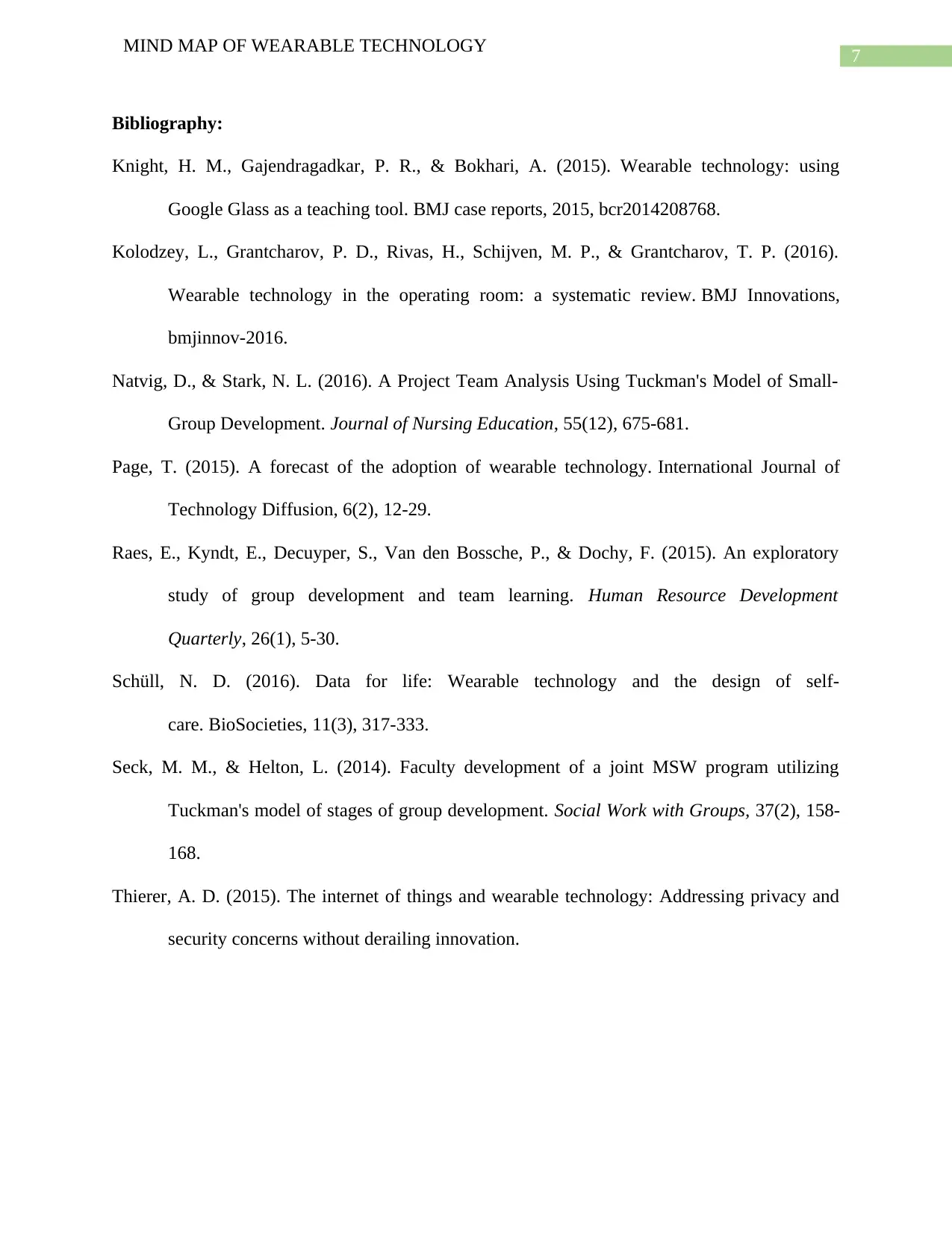
7
MIND MAP OF WEARABLE TECHNOLOGY
Bibliography:
Knight, H. M., Gajendragadkar, P. R., & Bokhari, A. (2015). Wearable technology: using
Google Glass as a teaching tool. BMJ case reports, 2015, bcr2014208768.
Kolodzey, L., Grantcharov, P. D., Rivas, H., Schijven, M. P., & Grantcharov, T. P. (2016).
Wearable technology in the operating room: a systematic review. BMJ Innovations,
bmjinnov-2016.
Natvig, D., & Stark, N. L. (2016). A Project Team Analysis Using Tuckman's Model of Small-
Group Development. Journal of Nursing Education, 55(12), 675-681.
Page, T. (2015). A forecast of the adoption of wearable technology. International Journal of
Technology Diffusion, 6(2), 12-29.
Raes, E., Kyndt, E., Decuyper, S., Van den Bossche, P., & Dochy, F. (2015). An exploratory
study of group development and team learning. Human Resource Development
Quarterly, 26(1), 5-30.
Schüll, N. D. (2016). Data for life: Wearable technology and the design of self-
care. BioSocieties, 11(3), 317-333.
Seck, M. M., & Helton, L. (2014). Faculty development of a joint MSW program utilizing
Tuckman's model of stages of group development. Social Work with Groups, 37(2), 158-
168.
Thierer, A. D. (2015). The internet of things and wearable technology: Addressing privacy and
security concerns without derailing innovation.
MIND MAP OF WEARABLE TECHNOLOGY
Bibliography:
Knight, H. M., Gajendragadkar, P. R., & Bokhari, A. (2015). Wearable technology: using
Google Glass as a teaching tool. BMJ case reports, 2015, bcr2014208768.
Kolodzey, L., Grantcharov, P. D., Rivas, H., Schijven, M. P., & Grantcharov, T. P. (2016).
Wearable technology in the operating room: a systematic review. BMJ Innovations,
bmjinnov-2016.
Natvig, D., & Stark, N. L. (2016). A Project Team Analysis Using Tuckman's Model of Small-
Group Development. Journal of Nursing Education, 55(12), 675-681.
Page, T. (2015). A forecast of the adoption of wearable technology. International Journal of
Technology Diffusion, 6(2), 12-29.
Raes, E., Kyndt, E., Decuyper, S., Van den Bossche, P., & Dochy, F. (2015). An exploratory
study of group development and team learning. Human Resource Development
Quarterly, 26(1), 5-30.
Schüll, N. D. (2016). Data for life: Wearable technology and the design of self-
care. BioSocieties, 11(3), 317-333.
Seck, M. M., & Helton, L. (2014). Faculty development of a joint MSW program utilizing
Tuckman's model of stages of group development. Social Work with Groups, 37(2), 158-
168.
Thierer, A. D. (2015). The internet of things and wearable technology: Addressing privacy and
security concerns without derailing innovation.
1 out of 8
Your All-in-One AI-Powered Toolkit for Academic Success.
+13062052269
info@desklib.com
Available 24*7 on WhatsApp / Email
![[object Object]](/_next/static/media/star-bottom.7253800d.svg)
Unlock your academic potential
Copyright © 2020–2025 A2Z Services. All Rights Reserved. Developed and managed by ZUCOL.

